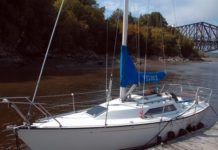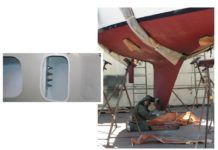Morgan 24/25
Back in 1965, a St. Petersburg, Florida sailmaker named Charlie Morgan, who had been dabbling with custom racing yacht design and had come up with a remarkable string of winners, started producing a series of small- to medium-sized production boats. Introduced late that year, the Morgan 24 joined the Morgan 30, 34 and 38, becoming an instant success as a fast cruiser and club racer.
Tartan 31
The Tartan 31 is one of the new line of performance cruising yachts from the venerable-and durable--Grand River, Ohio boatbuilder. In the last few years, Tartan Marine has come out with a range of new models, including the T-28, the 3500 and the 4600. A 41-footer is in the works. Both the 28 and the latest version of the 31 are part of the new Piper series, which are marketed in sailaway condition. Tartan has a reputation for solid construction and good workmanship and that's what the 31 is: solid and well put together. The hull is hand-laminated with alternating layers of chopped strand mat and unidirectional E glass. Behind the NPG/ISO gelcoat there's a layer of vinylester resin, which so far appears to provide the best osmotic blister protection available.
Allied Princess 36
When you first see this boat, either in the water or on paper, the two things that immediately strike you are the sheer and bow. Edmunds put the low point of the sheer at the right place, about two-thirds of the distance aft from the bow. But the bow seems awfully high. In fact, when you walk forward along the sidedecks, you have the definite sensation of walking uphill. Too much, we think, though the look certainly sets the Princess apart from boats with flatter sheers (again, the Pearson 365 comes to mind).
C&C 27 Boat Review
This fast and handsome cruiser/racer from the 1970s is an excellent example of what made C&C Yachts such a successful company. C&C stands for George Cuthbertson & George Cassian, the design team that, in 1969, joined in partnership with Belleville Marine Yard, Hinterhoeller Ltd. and Bruckmann Manufacturing to form C&C Yachts. The company had a tumultuous history, from growing to capture an estimated 20 percent of the U.S. market during the 1970s, to suffering a devastating fire in 1994 while owned by Hong Kong businessmen Anthony Koo and Frank Chow of Wa Kwang Shipping. Along the way, they built a tremendous number of boats, not only in the racer/cruiser genre that was their mtier, but also the Landfall cruiser line, and a few oddballs such as the 1977 Mega 30 with a retractable fin keel; the Mega 30 and a handful of others simply bombed.
The Evolution of the C&C 27 Cruiser-Racer
C&C Yachts produced four versions-and nearly 1,000 hulls-of its popular C&C 27 boat. Called the C&C 27 Mark I, Mark II, Mark III, and Mark IV, these boats differed in various ways, but the hulls were similar. A fifth design, the C&C 27 Mark V, was a totally different design. Heres a look at the various editions of the C&C 27, and how they differed from one another.
CS 36
The CS 36, despite its small, reverse counter transom, still looks fairly modern today, with its rakish bow, low-profile cabin and tall, singlespreader rig.
Bristol Channel Cutter, Morris 40, Alerion Sloop
The Alerion Sloop, Bristol Channel Cutter and Morris 40 cover the range from gentleman's daysailer to blue-water passagemaker. Each is of superior design and construction-it's nice to know you can still buy quality, but you'd better have deep pockets.
The Modern Classic Racer-Cruiser
The Islander 36 was built from 1971 to 1985, making it one of the longest-lived 36-footers ever on the U.S. market. More than 750 of the Alan Gurney-designed racer-cruiser sloops were built, with production spanning almost the entire history of Islander Yachts.
Age Calls for Close Inspection
The Islander 36 is a fairly light-displacement boat. The hand-laid hull is an uncored, single skin, with polyester resin and fiberglass furniture components adding rigidity. The hull and plywood-core deck are bolted together at close intervals through an aluminum toerail.
Tall-step Syndrome
Boat shows present a wonderful opportunity to not only explore boats well beyond your price range, but also to observe how designers answer the many compromises that each boat design requires. Some designs succeed, and some don't-and often the weak spot is a simple failure to understand the customer.














































